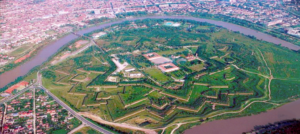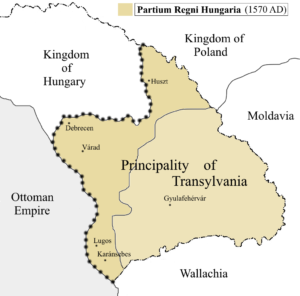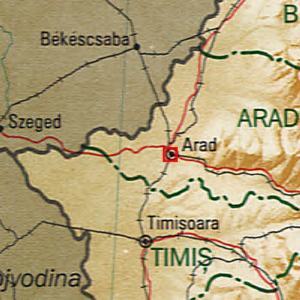
Arad

Arad can be found in Romania but it used to belong to the Transylvanian Principality and to the Kingdom of Hungary. Its history cannot be interpreted coherently outside the context of Hungarian history. In fact, the settlement had several fortifications and the medieval city center had been on a slightly different location. Now, we can visit only the early modern fortification and pay honor to the martyrs, the Hungarian generals who were executed outside the fort on 6 October 1849.

According to the map drawn by Szatmári T., the settlement was situated at the Maros (Mures) River, the first earthen fortification was built in at Öthalom the age of King Saint István (see: number 1) in the 11th century. The second castle (number 2) used to be a Borderland castle, it was a palisade fort, it was built in 1552 and rebuilt several times. It was pulled down in 1767. The third one is the star fort that was built in 1767 while the fourth location shows the medieval agricultural town of Arad.

Arad used to be a center of a Hungarian County in the 11th century, it was the headquarters of the Comes of Arad. The first fort was called “Orod” and it stood 7 kilometers to the east of the present town, at Öthalom village (meaning “Five hills”) but it was destroyed by the Mongolian invasion in 1241. The new town was built on the western bank of the Maros River, it gave shelter to many refugees who fled there before the Ottoman Empire’s expansion. (Please, note that I use the Eastern name order for Hungarian names where family names come first.)
The town was taken by the Turks in 1551 and the Turks built a new palisade fort between 1552-1554. During the Ottoman rule (1551-1687) it was a strategic Borderland castle of the Ottomans but its trading function was even larger. The famous Turkish traveler, Evlija Cselebi was writing about Arad in detail. Arad wasn’t a peaceful place, due to its location between Royal Hungary, the Principality of Transylvania, and the Ottoman-Occupied Lands.
During the 15-Year War, the castle was retaken by Prince Báthori Zsigmond in 1595 for a while. He gifted collective nobility to the Serbian soldiers who had defended heroically the castle of Lippa and they were given the town of Arad for their services. You can read more about the 15-Year-War aka Long War here:
https://www.hungarianottomanwars.com/chronologie/the-fifteen-year-war-series-1591-1606/

When Bethlen Gábor became the Prince of Transylvania (1613-1629), he had to give the fully destroyed Arad back to the Ottomans, along with Lippa castle. He was not loved for this deed by the Hungarian warriors: the warriors of Lippa even had to be besieged by Bethlen. He had to force them to give their fort back to the Turks. But this was the price for gaining his princely title: Bethlen needed the Turks’ support at the beginning of his reign. Prince Rákóczi György II (1648-1660) could take Arad back again, chasing away the Turkish garrison and putting the palisade on fire. However, the Ottomans took the forts along the river Maros back a bit later and they rebuilt the castle of Arad. It was retaken by the Habsburg “liberators” in 1688.

Arad castle was in very bad condition and although it was repaired in 1698, it ceased to be a Borderland castle in 1718. The present fortifications were mainly built by the Habsburgs who made Arad a free royal town at the same time. It was Empress Maria Theresia who could finally carry out the construction. At first, in 1750 she banned the locals from settling near the location of the new fort. Then, she allocated the forest-covered island at the bend of the Maros River for the star fort.

It was built according to the plans of General Philipp Ferdinand Harsch, in the form of a shield with a hexagram in the middle, with six corners, built with three rows of underground pillboxes and several trenches which in the past could be flooded. It was completed between 1763-83, its area was about 730,000 square meters. There were bastions on each side, and six gates were constructed. The garrison could be as large as 3,600 soldiers in case of need, supplied with 296 cannons.
Starting from 1794, the fortress was used as a military prison when 1200 French soldiers were imprisoned. During the 1848–1849 Hungarian Revolution, the fortress played a key role as it was besieged by the Hungarian Republican army. After a long and bloody siege, it was finally surrendered on 28 June 1848. When the Revolution was put down with Russian assistance, it was General Damjanich János who ceded the fort to the Russian army on 17 August.

The Habsburg army moved back into the fortress and used it partly as a military prison. Among the executed officers were Damjanich and the 12 other Generals of the Republican Army who were killed on October 6, at the outer east walls of the fortress. Today, Hungarians consider them martyrs and commemorate their execution. The Fort of Arad today is the only Vauban-style fort in Eastern Europe that has survived in the most intact form. Sadly, it is still being used by the army and the buildings belonging to the cultural heritage of both Hungary and Romania are in very bad condition.

Dear Readers, I can only make this content available through small donations or by selling my books or T-shirts:
Please, feel free to support me with a coffee here:
You can check out my books on Amazon or Draft2Digital, they are available in hardcover, paperback, or ebook:
https://www.amazon.com/dp/198020490X or at https://books2read.com/b/boYd81

My work can also be followed and supported on Patreon: Become a Patron!http://Become a Patron!

[wpedon id=”9140″]

https://hungarianottomanwars.myspreadshop.com/all



































